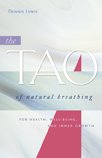 My friend Dennis Lewis has recently announced the re-publishing by Rodmell Press of one of the best books available on breathing and the breath: “The Tao of Natural Breathing.”
My friend Dennis Lewis has recently announced the re-publishing by Rodmell Press of one of the best books available on breathing and the breath: “The Tao of Natural Breathing.”
In conjunction with the release of the book, Dennis circulated the following piece, which mentions “The Future of Breathing,” the symposium I organized last September at Kripalu. I hope to work again soon with Dennis and some of the other presenters on a follow-up event – possibly in 2007.
(OPENPRESS) April 11, 2006 — When “The Tao of Natural Breathing” was first published back in late 1996, yoga breathing, or pranayama, was all the rage. “It still is today,” says Dennis Lewis, author of this acclaimed book, “but at least now a growing number of people, including yoga teachers, are questioning the wisdom of teaching advanced pranayama exercises to people who don’t breathe very well to begin with.” They are also opening themselves to some recent research about the meaning of healthy breathing…click “Read more!” to view the rest of this post.
Last year, for example, Lewis was one of several presenters at “The Future of Breathing” Conference held at The Kripalu Center for Yoga & Health. Lewis points out that one of the goals of this conference, which was organized by Leslie Kaminoff, a leading yoga teacher and therapist, was to expose and correct some of the many myths about breathing that are still being taught today by many yoga teachers and appear in many books. One of the biggest myths of all is the belief that the more carbon dioxide you can breathe out with each breath the better. “The fact is, if you exhale too much carbon dioxide too quickly,” Lewis says (and many researchers agree), “you often not only make yourself more anxious and irritable, but you can create or exacerbate many serious health problems.” Lewis explains the reasons for this in his book “The Tao of Natural Breathing,” as well as in his latest book “Free Your Breath, Free Your Life.”
But there are other problems with teaching advanced pranayama exercises to people who are not ready for them. In his book “The Tao of Natural Breathing,” Lewis points out that “Breathing exercises involving complicated counting schemes, alternative nostril breathing, reverse breathing, breath retention, hyperventilation, and so on only make sense for people who already breathe naturally, making use of their entire body in the breathing process.” Lewis believes that though these advanced practices can result in novel and even useful energetic experiences, they often do so–for people who don’t breathe well–at the expense of making their breathing even worse over the long run.
Though “The Tao of Natural Breathing” has been out of print for the past year, Rodmell Press, which specializes in books on yoga, has just republished it. Although one might think that the book would not be welcome by yoga teachers, there has been a growing awareness among yoga teachers of many of the points that Lewis makes in this book, especially with regard to the importance of “natural breathing,” which “The Tao of Natural Breathing” was written to help make possible. And so one finds may yoga teachers who think highly of this book and recommend it to their students. One well-known yoga teacher has this to say:
“Insightful in its breadth and simple in its presentation, ‘The Tao of Natural Breathing’ offers something new, especially to those skilled in pranayama (yoga breathing exercises). Dennis Lewis presents practices that are less about control and more about letting go. He gently entices us to allow our conscious breath to become the teacher, the healer, and the expression of our soul.” –Judith Hanson Lasater, Ph.D., P.T., author of 30 Essential Yoga Poses
For more information about “The Tao of Natural Breathing” and “Free Your Breath, Free Your Life,” visit The Authentic Breathing Website.
For more information about Dennis Lewis, visit http://www.dennislewis.org.
